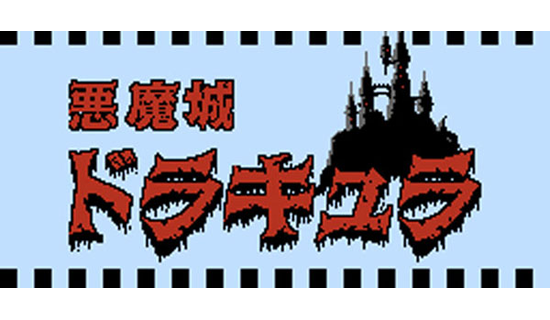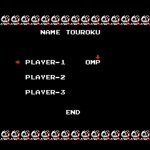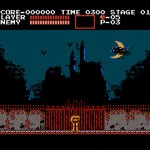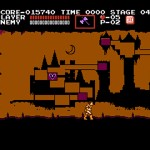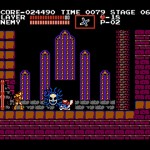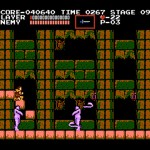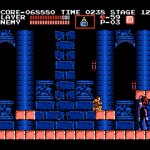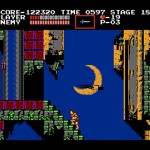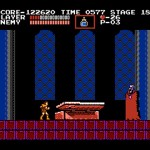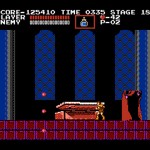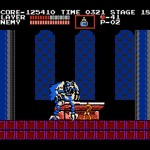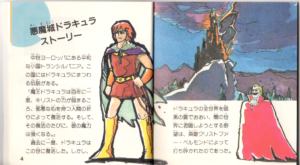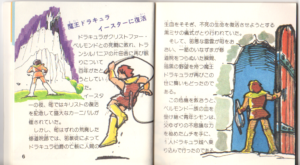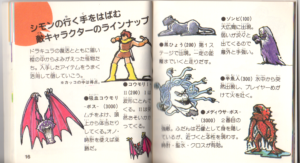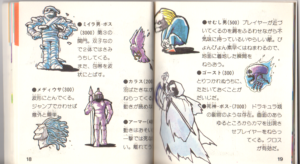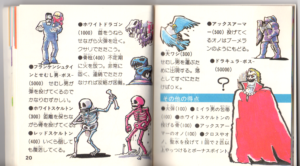When you think about the first entry in the Castlevania/Dracula series, you probably think about two things: The incredible atmosphere and the high level of difficulty. Neither of these things change when you go from any of the western versions to the Japanese one, though some qualities of the Japanese version alter the difficulty slightly. A common point of frustration in the Western versions of the game is that you can’t save your game at all, unless you’re playing on one of those fancy emulators. But how would it change Castlevania’s difficulty if you could save your progress each time you got a game over?
In the bizarro world that is Japan, you could do just that! Why was this feature taken out of the Western version? Castlevania was released in Japan on the Famicom Disk System, rather than on a regular Famicom/NES cartridge (though it would be much later on, in 1993). This meant that saving your progress did not require the creation of a password system or the inclusion of a battery inside of the game cartridge, since it could be written directly to the floppy disk. Apparently it wasn’t deemed worthwhile to develop a password system for the Western release (as was done by Nintendo for the Western release of Metroid, for example), or it simply never occurred to anyone. The ability to save progress obviously makes playing through this difficult game much more manageable. Even though playing it on the Disk System results in some load time, it’s arguably the definitive way to play a physical version of Castlevania.
The Disk System debuted on February 21st 1986, and this was Konami’s first piece of software for it. Truly story driven games weren’t common at this point, most home games were trying to emulate an arcade-like experience. Castlevania certainly has an arcade feel to it (in fact an arcade conversion would be released a year later: VS. Castlevania) and you get no explicit story telling throughout except for the impressive opening sequence of Simon Belmont opening the gate to Dracula’s castle. This doesn’t mean that there wasn’t thought put into the story though! The following is a translation of the story straight from the Japanese manual:
There is a legend that says once every 100 years in Transylvania, when Christ’s power is at its weakest, Castle Dracula will be resurrected from the prayers of the wicked-hearted. At this time, evil magic grows stronger. Dracula was brought back to this world once in the past, but was stopped by Christoper Belmont. He returned Dracula to his slumber in the Transylvanian countryside.
On Easter night 100 years later, a grand carnival celebrating Christ’s rebirth was held. On the outskirts of town in a ruined monastery, heretics poured blood of the living onto the corpse of Count Dracula in a black mass ritual. Suddenly black clouds covered the city, and blinding flashes of lightning struck the monastery. Count Dracula returned to the world once again. Simon Belmont of the Belmont clan took up his whip, containing mysterious powers, that has been passed down through his family. He set off alone to Dracula’s castle.
In 1986, this story was more than enough to set minds ablaze! To enhance this thrilling back story, the game uses one very key element that sets it apart from so many of its contemporaries: Atmosphere. The foremost element in setting up this atmosphere is the sense of change that the player feels when they’re moving through each level of Dracula’s castle. That is to say, each level is actually set in a different part of the castle. This gives you the feeling of moving through the castle toward Dracula, instead of just playing re-skins of previous levels with only slight differences. The map of the castle that’s shown between levels supports this idea, since you can see yourself getting closer to the final showdown. The bosses for each area of Dracula’s castle also include some well known creatures of horror: Frankenstein, Medusa, The Mummy, The Grim Reaper, and more. Determining the best strategy to beat each of these formidable bosses is an important part of the game as well. Pattern observation and having the right sub weapon (Hint: it’s almost always holy water) is key to getting through them. While certain liberties were taken in the way some of these monsters were presented, their depictions are all very loving ones in the end. Try not to take it too personally, old horror movie buffs.
The other component in creating Castlevania’s atmosphere is one that’s recognized by many, and rightfully so: The music. Composer Kinuyo Yamashita did an absolutely superb job in creating tracks that not only perfectly fit the Gothic atmosphere of Castlevania, but also were of superior quality when compared to a lot of the music that we’d heard on the Famicom or Disk System thus far. Not to mention this was her debut work as a game composer! The music of this series will continue to be a high point throughout its life, and its creation will end up falling to a few different composers. There can be no doubt that we have Yamashita’s original compositions, as well as her further involvement in the arrangement of the soundtracks to thank for such continued high quality. All of her compositions would go on to be remixed and reworked by other composers later on as well.
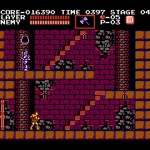 | 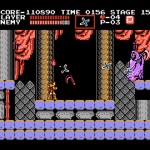 |
| Those who can’t grasp the intricacies of the controls will dread their encounters with…the stairs! | One of the hardest boss fights in the game: The Grim Reaper. Basically there are sickles everywhere. |
As mentioned previously, this game is known for its high level of difficulty. Some common reasons for this are the inability to control Simon mid-jump, having to hold directions to ascend and descend stairs and the rather large knock-back to Simon when hit by an enemy. While all of these things are legitimate flaws by today’s control standards, they’re by no means insurmountable. Learning to understand Simon’s jump arch is essential, and once you do it won’t matter anymore that you can’t change his direction mid-jump. You’ll know if you didn’t execute a jump correctly the moment you do it. It’s also completely possible to make it through this game without the ability to save, even though you have to be dedicated to learning many enemy patterns, strategies for more easily defeating bosses, and the best ways to hold onto that holy water and get those II and III power-ups to increase the amount of them that you can throw in one burst. There are some particularly frustrating parts in the game (perhaps most notably the fight against the Grim Reaper), but none of them stop it from being fun. Many call this an essential game of the 8-bit era, and for very good reason. It’s a quality action platformer all the way through.
If you’re good enough to make it through the game and defeat Dracula, you’re treated to a rather amusing credits sequence in which classic horror movie-themed aliases are used. For the staff portion of the credits, they’re credited with roles in the same way that they might be in a movie: Directed by Trans Fishers, Screenplay by Vram Stroker, and Music by James Banana. Though it’s made extra amusing in this case due to the theme, it wasn’t at all uncommon at this point in Japanese game development to use aliases for staff in the credits. This was because companies were afraid of their staff being poached by another company if their full names were listed. Even the characters themselves got credits though: Dracula – Christopher Bee, Death – Belo Lugosi, Frankenstein – Boris Karloffice, Mummy Man – Love Chaney Jr., Medusa – Barber Sherry, etc.
For those who don’t want to invest in a Famicom Disk System or emulate, you have a few different options. The contents of the Famicom cartridge version that was released much later on are mostly the same, but it includes a new easy mode to compensate for the lack of a save feature. Because the Super Famicom was Nintendo’s main console at the time, not many copies of this cartridge were produced. That makes it quite rare and expensive. A Game Boy Advance version also came out in 2004 as part of the Famicom Mini collection, complete with the ability to save progress. Lastly, you can download this game from the Wii, Wii U and 3DS Virtual Consoles in all regions.
If you’ve played later entries in this series, it’s pretty fascinating to go back and look at the straightforward action platforming roots. Some prefer this type of Castlevania game, and some prefer the Metroidvania type that’s yet to come, but this is where it all began.
(The following are scans of some of the amusing art found in the instruction manual of the Famicom Disk System version)
And here is the Japanese TV commercial
